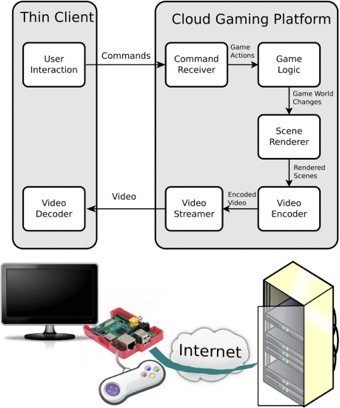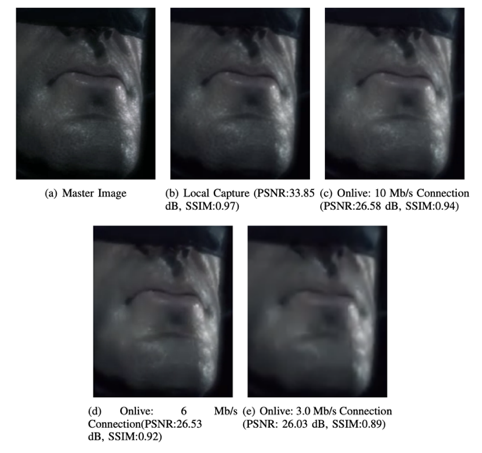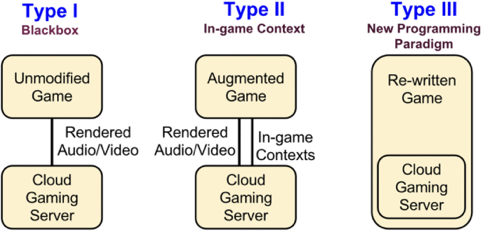Cloud Gaming Literature Review

|
Author: Chris Miceli |

|
Dated: 2018-12-13 |

|
Uploaded: 2018-12-13 |

|
Last Edited: 6 years ago |
Abstract
What are the drawbacks and benefits of cloud technology applied to the gaming industry?
This research paper aims to constructively analyse the available literature relating to the drawbacks and benefits cloud technology will have on the gaming industry. Research is carried out into latency and image quality provided by leading cloud gaming services, followed by an analysis of industry and consumer benefits. Arguments from a variety of relevant sources are critically appraised, and any limitations which have become apparent whilst conducting this literature review have been identified. The research carried out in this paper is intended to support the development of an upcoming work-based research project.
Introduction
The gaming industry has been evolving since the1950’s, with many innovations having changed the way we experience and interact with games over time. However the fundamental concepts of local graphics processing have never truly been challenged until the development of cloud technology and streaming services (Riad Chikhani, 2015). Eliminating consumer investment in expensive hardware through cloud gaming, or thin client gaming, provides the industry with access to a larger audience. However, crucial issues need to be addressed before the technology has the potential to reshape the industry; most notably of which being latency.
Cloud gaming, a specialisation of cloud computing, is a concept which allows video games to be run on almost any internet connected client, regardless of the local system specification and performance. This is achieved by offloading graphical processing workloads to a remote server, and subsequently receiving a stream of processed image frames, to be displayed on the thin client (Bryce Mariano; Simon G. M. Koo, 2014). The client requires minimal processing capabilities, and is only used to send commands to the server over a standard internet connection, and decode the received video stream in real time. See Appendix A for a pictorial representation of the cloud computing model.
The first cloud gaming business model was attempted in 2004, however it took five years for serious drawbacks to be resolved and for recognisable industry brands to gain traction. Many sources indicate the OnLive and Gaikai services are the most successful companies in this sector, having the largest subscription counts (M. Manzano; J. A. Hernández; M. Urueña; E. Calle, 2012). Soon after the technology’s potential was demonstrated, reputable companies entered the Gaming as a Service (GaaS) market, such as Sony, Nvidia, Microsoft and HP, all of which are attempting to improve quality to match locally processed performance (Leo Sun, 2018). Market success in this category is often determined by Quality of Service (QoS), as well as by the size of their user-base.
It is apparent that, although research has been carried out on existing platforms and technology, the majority is focused on future developments. Since 2009, many global research teams as well as persons in academia have published several papers on their viewpoints and suggestions for unique approaches and improvements to technical implementations aimed at overcoming existing challenges (Wei Cai; Ryan Shea; Chun-Ying Huang; Kuan-Ta Chen; Jiangchuan Liu; Victor C. M. Leung; Cheng-Hsin Hsu, 2016). Notable proposed methods include low bit-rate transmission through layered coding, utilising big data to predict player behaviour (Client Side Prediction), and developing frameworks specific to mobile devices (Wei Cai; Victor C. M. Leung; Min Chen, 2013), among others. It is apparent that these and many approaches aim to tackle only one of the inherent issues being faced; game image quality, internet speed & reliability, and portability across low powered devices (Seong-Ping Chuah; Ngai-Man Cheung; Chau Yuen, 2016), (Sunanda Biradar; Nusrathjabeen Nagoor, 2017).
Although there are many hurdles to overcome before cloud gaming can match or surpass typical console or desktop experiences, the documented benefits associated with its implementation and mass adoption create enough incentive to justify further investments into research & development (Ideamine, 2017). Value is added at all links in the supply chain, from developers to consumers, with distributers being replaced by service providers in the cloud computing business model (Arto Ojala; Pasi Tyrväinen, 2011), (Dzhafer Medzhakhed, 2012). Developers would only need to develop their game for a server platform, instead of having to port software across multiple systems. In addition, piracy concerns are eliminated, as the source code is only loaded onto secure cloud servers, and is never locally stored on the user’s device. Service providers would benefit from a larger target audience due to reduced user cost and widespread accessibility. Aside from reduced end user cost resulting from the elimination of hardware maintenance, gamers would also gain the ability to choose from a wide variety of available titles, capable of being streamed nearly seamlessly across multiple devices.(Ryan Shea; Chun-Ying Huang; Kuan-Ta Chen; Jiangchuan Liu; Victor C. M. Leung; Cheng-Hsin Hsu; Wei Cai, 2016)
Cloud Gaming Challenges
Latency
Latency, measured in milliseconds, is defined as the average time taken for your device to send data to a server, and for a response to be subsequently received. Locally processed games require latency considerations when engaging in multiplayer aspects to ensure smooth gameplay, as user movement changes need to be quickly synchronised through a server across multiple geographically dispersed devices (Rachel Presser, 2018). Studies have proven a direct relationship between an increase in latency and a decrease in player performance, emphasising the importance of this criteria (Mark Claypool; David Finkel, 2014). It is commonly agreed that gameplay with a latency of less than 100ms is ideal, with anything over 400ms being unacceptable. However, it is also noted that the style of game being played (First Person Avatar, Third Person Avatar & Omnipresent) often determines acceptable latency criteria (Kjetil Raaen, 2014). These results can easily be achieved given today’s technological capabilities as only simple movement commands require transmission, whilst the environment is rendered locally (Jonas DeMuro, 2017). However, cloud gaming introduces an overhead to server-client communication, as in this configuration both the user commands and video signal must be transmitted and synchronised with one or multiple client devices, whilst maintaining a similarly satisfactory response time.
During a 2014 conference in China, a comparative study on cloud gaming platforms was presented, arguing that many cloud data centre locations are chosen to minimise cooling and electricity costs, rather than to minimise latency to end-users. It was determined that this factor would increase cost to service providers, who would be required to deploy servers in previously undesirable and costly locations with the goal of reducing latency; a requirement for delivering a positive and smooth gaming experience in the cloud (R. Gharsallaoui; M. Hamdi; T. Kim, 2014). This has been found to directly contradict ongoing studies in the field, which state that it is unlikely for two competing services operating in the same geographic region to suffer from noticeable in game latency discrepancies. Tests carried out in the paper ‘On the Quality of Service of Cloud Gaming Systems’ compared processing delay and client playout delay between OnLive and StreamMyGame cloud gaming services in California. Results scientifically proved that when guaranteed a stable uninterrupted network, sufficient bandwidth and low packet loss rate, sustainable latency can be achieved regardless of distance from the server (Kuan-Ta Chen; Yu-Chun Chang; Hwai-Jung Hsu; De-Yu Chen; Chun-Ying Huang; Cheng-Hsin Hsu, 2013).
The conclusions reached do not imply latency concerns surrounding cloud gaming environments are unwarranted, as averagely configured cloud computing servers do not provide the desired requirements for the purpose (Phillip Kent, 2017). However it is suggested that the continental location of graphical processing servers will not noticeably impact latency overhead, therefore it is more beneficial to invest resources in server configuration and fine tuning in order to enhance user experience. Refer to Appendix B for a comparison between an optimised and averagely configured cloud gaming server.
Image Quality
A bandwidth of 2-3 Mbps is the guaranteed minimum required by most cloud gaming services for a ‘good’ Quality of Service, with 5 Mbps being recommended (M. Manzano; J. A. Hernández; M. Urueña; E. Calle, 2012). Generally, a higher bandwidth results in superior image quality. See Appendix C for an image quality comparison at various bandwidths. In order to stream the large amounts of video data over a limited bandwidth and within a reasonable time, the stream needs to be compressed using an algorithm.
Due to support across a plethora of devices, the H.264 algorithm has become the standard video codec for image de/compression for cloud gaming (Parsec, 2016). Although highly compatible, it has been shown to be comparably inefficient for the purpose (Seong-Ping Chuah; Ngai-Man Cheung; Chau Yuen, 2016), (Shu Shi; Cheng-Hsin Hsu; Klara Nahrstedt; Roy Campbell, 2011). Codecs are generally designed to process a specific type of graphical content, from cartoons to highly realistic scenery. Therefore having a single codec responsible for processing a wide variety of graphical data, often within the same gameplay, imposes limitations on the potential image quality. Furthermore, due to the lack of support for cross-layer optimisation, proposed techniques such as layered coding would be rendered ineffective (Kuan-Ta Chen; Chun-Ying Huang; Cheng-Hsin Hsu, 2014). Codecs which are capable of more efficiently handling a wider variety of content currently exist, however adoption has been gradual. Companies such as Netflix are developing new codecs with targets of 50% bandwidth savings, and due to their market dominance, such technologies are likely to become widely available in a shorter timespan (Omar Soliman; Abdelmounaam Rezgui; Hamdy Soliman; Najib Manea, 2013).
Cloud Gaming Benefits
Once quality of service challenges are overcome, the cloud gaming industry can expect to see some substantial benefits over traditional gaming solutions. The most incentivising is the cost aspect, both for companies and consumers. The subscription service models adopted by streaming companies allows a steady and predictable flow of income allowing for more efficient cashflow, as opposed to the current unpredictable one time purchase of hardware and software (Daniel Howley, 2018). From the consumer point of view, such services eliminate the requirement for investment in purchasing or upgrading expensive hardware, and replaces it with an experience of equal quality for a fraction of the cost. In addition, it eliminates the added cost of purchasing individual games, and instead offers a vast library of titles. (Tobias Hobfeld; Raimund Schatz; Martin Varela; Christian Timmerer, 2012)
Many articles suggest that advanced cloud gaming will dictate new programming paradigms, requiring games to be re/written using optimised software development kits (SDK’s) which take advantage of the advanced technology offered by the cloud infrastructure (Ryan Shea; Chun-Ying Huang; Kuan-Ta Chen; Jiangchuan Liu; Victor C. M. Leung; Cheng-Hsin Hsu; Wei Cai, 2016). See Appendix C for Cloud Gaming Classifications, depicting the eventual shift to advanced implementations which make use of new programming paradigms. Although this will create a steeper learning curve for cloud developers, the eventual shift will eliminate the requirement of porting versions for various system types. This is projected to significantly reduce development time and cost, allowing for a more streamlined process. (Chelsea James, 2017), (Tabitha Baker, 2018)
Conclusion
A 2016 paper outlining the future of cloud gaming argues that many cloud gaming service providers have overcome ‘initial growth pains’, and that the technology is ready ‘to be deployed in living rooms everywhere’ (Ryan Shea; Chun-Ying Huang; Kuan-Ta Chen; Jiangchuan Liu; Victor C. M. Leung; Cheng-Hsin Hsu; Wei Cai, 2016). Many sources would suggest that for the casual gamer, this may be true. However, those who are already willing to invest in hardware capable of delivering high quality gaming experiences would likely be unwilling to embrace the technology until quality of service discrepancies become negligible.
This literature review has brought to light some key restrictions surrounding cloud gaming technology in its present form. It is apparent that a vast amount of research is being carried out on the subject, with the objective of perfecting the underlying implementation in order to improve quality of service. Much of the work required to achieve desirable quality revolves around decreasing latency and improving image quality through optimising server configurations, fine tuning network connections and enhancing de/compression algorithms. The outlined benefits indicate the potential for improved business models and customer experience as a result of such an industry shift. Much of the research carried out into underlying concepts, prevalent issues and industry benefits provides background and sufficient knowledge to establish solid foundations for the development of a substantial cloud gaming based research project.
References
- Riad Chikhani (2015). The History Of Gaming: An Evolving Community. Available at: https://techcrunch.com/2015/10/31/the-history-of-gaming-an-evolving-community/ Accessed on December 11th, 2018
- Bryce Mariano; Simon G. M. Koo (2014). Is cloud gaming the future of the gaming industry?. Available at: https://ieeexplore.ieee.org/document/7182690 Accessed on December 11th, 2018
- M. Manzano ; J. A. Hernández ; M. Urueña ; E. Calle (2012). An empirical study of Cloud Gaming. Available at: https://ieeexplore.ieee.org/document/6404021 Accessed on December 11th, 2018
- Leo Sun (2018). 4 Companies Betting on Cloud Gaming. Available at: https://www.fool.com/investing/2018/04/17/4-companies-betting-on-cloud-gaming.aspx Accessed on December 11th, 2018
- Seong-Ping Chuah; Ngai-Man Cheung; Chau Yuen (2016). Low Bit-rate Mobile Cloud Gaming. Available at: https://www.researchgate.net/publication/304358745_Low_Bit-rate_Mobile_Cloud_Gaming Accessed on December 11th, 2018
- Sunanda Biradar; Nusrathjabeen Nagoor (2017). A Review on Cloud Gaming. Available at: https://www.researchgate.net/publication/318498100_A_Review_on_Cloud_Gaming Accessed on December 11th, 2018
- Wei Cai; Victor C. M. Leung; Min Chen (2013). Next Generation Mobile Cloud Gaming. Available at: https://www.researchgate.net/publication/255993435_Next_Generation_Mobile_Cloud_Gaming Accessed on December 11th, 2018
- Wei Cai; Ryan Shea; Chun-Ying Huang; Kuan-Ta Chen; Jiangchuan Liu; Victor C. M. Leung; Cheng-Hsin Hsu (2016). A Survey on Cloud Gaming: Future of Computer Games. Available at: https://ieeexplore.ieee.org/abstract/document/7536162 Accessed on December 11th, 2018
- Ideamine (2017). Top 8 Benefits of Cloud Computing in Gaming Industry. Available at: https://www.ideaminetech.com/blog/top-8-benefits-cloud-computing-gaming-industry/ Accessed on December 11th, 2018
- Ryan Shea; Chun-Ying Huang; Kuan-Ta Chen; Jiangchuan Liu; Victor C. M. Leung; Cheng-Hsin Hsu; Wei Cai (2016). The Future of Cloud Gaming. Available at: https://people.cs.nctu.edu.tw/~chuang/pubs/pdf/2016pieee.pdf Accessed on December 11th, 2018
- Arto Ojala; Pasi Tyrväinen (2011). Developing Cloud Business Models: A Case Study on Cloud Gaming. Available at: https://www.researchgate.net/publication/220092667_Developing_Cloud_Business_Models_A_Case_Study_on_Cloud_Gaming Accessed on December 11th, 2018
- Dzhafer Medzhakhed (2012). Who Will Benefit From Cloud Gaming?. Available at: https://seekingalpha.com/article/594531-who-will-benefit-from-cloud-gaming Accessed on December 11th, 2018
- R. Gharsallaoui; M. Hamdi; T. Kim (2014). A Comparative Study on Cloud Gaming Platforms. 7th Conference on Control and Automation (CA), Hainan Island, China, 2014, pp. 28-32. Available at: https://www.computer.org/csdl/proceedings/ca/2014/8205/00/07026255-abs.html Accessed on December 11th, 2018
- Rachel Presser (2018). The Importance of Latency in Online Gaming. Available at: https://www.bandwidthplace.com/the-importance-of-latency-in-online-gaming/ Accessed on December 11th, 2018
- Jonas DeMuro (2017). What are latency and ping and what do they mean for gaming?. Available at: https://www.pcgamer.com/uk/what-are-latency-and-ping-and-what-do-they-mean-for-gaming/ Accessed on December 11th, 2018
- Kuan-Ta Chen; Yu-Chun Chang; Hwai-Jung Hsu; De-Yu Chen; Chun-Ying Huang; Cheng-Hsin Hsu (2013). On the Quality of Service of Cloud Gaming Systems. Available at: http://mmnet.iis.sinica.edu.tw/pub/chen14_cloud_gaming_qos.pdf Accessed on December 11th, 2018
- Mark Claypool; David Finkel (2014). The Effects of Latency on Player Performance in Cloud-based Games. Available at: http://web.cs.wpi.edu/~claypool/papers/cloud-games/paper.pdf Accessed on December 12th, 2018
- Kjetil Raaen (2014). Latency Thresholds for Usability in Games: A Survey. Available at: https://pdfs.semanticscholar.org/6214/db8781e96bc459b0e45514340bb25672831a.pdf?_ga=2.204451544.992825366.1544656883-1518489475.1540155786 Accessed on December 12th, 2018
- Phillip Kent (2017). How to improve cloud latency and throughput: How good is your cloud provider's network?. Available at: https://cloudstore.interoute.com/knowledge-centre/blog/improve-cloud-latency-throughput-how-good-providers-network Accessed on December 12th, 2018
- Ryan Shea; Jiangchuan Liu; Edith C.-H. Ngai; Yong Cui (2013). Cloud Gaming: Architecture and Performance. Available at: https://www.sfu.ca/~rws1/papers/Cloud-Gaming-Architecture-and-Performance.pdf Accessed on December 12th, 2018
- Parsec (2016). The Technology Behind A Low Latency Cloud Gaming Service. Available at: https://blog.parsecgaming.com/description-of-parsec-technology-b2738dcc3842 Accessed on December 12th, 2018
- Seong-Ping Chuah; Ngai-Man Cheung; Chau Yuen (2016). Title. Available at: https://ieeexplore.ieee.org/document/7466839 Accessed on December 12th, 2018
- Shu Shi; Cheng-Hsin Hsu; Klara Nahrstedt; Roy Campbell (2011). Using graphics rendering contexts to enhance the real-time video coding for mobile cloud gaming. Available at: https://www.researchgate.net/publication/221573521_Using_graphics_rendering_contexts_to_enhance_the_real-time_video_coding_for_mobile_cloud_gaming Accessed on December 12th, 2018
- Kuan-Ta Chen; Chun-Ying Huang; Cheng-Hsin Hsu (2014). Cloud gaming onward: research opportunities and outlook. Available at: https://ieeexplore.ieee.org/abstract/document/6890683 Accessed on December 12th, 2018
- Omar Soliman; Abdelmounaam Rezgui; Hamdy Soliman; Najib Manea (2013). Mobile Cloud Gaming: Issues and Challenges. Available at: https://www.cs.nmt.edu/~rezgui/Papers/MobiWis13.pdf Accessed on December 12th, 2018
- Daniel Howley (2018). New technology could upend the video-game market. Available at: https://finance.yahoo.com/news/new-netflix-style-system-change-play-video-games-135708043.html Accessed on December 12th, 2018
- Tobias Hobfeld; Raimund Schatz; Martin Varela; Christian Timmerer (2012). Challenges of QoE management for cloud applications. Available at: https://ieeexplore.ieee.org/abstract/document/6178831 Accessed on December 12th, 2018
- Chelsea James (2017). Streamline Case Study: Accelerated Launch with Amazon GameLift. Available at: https://aws.amazon.com/blogs/gametech/streamline-case-study-amazon-gamelift/ Accessed on December 12th, 2018
- Tabitha Baker (2018). Cloud Gaming Is The Future, And It’s Up To Indie Devs To Prove That. Available at: https://www.indiegamewebsite.com/2018/11/21/cloud-gaming-is-the-future-and-its-up-to-indie-devs-to-prove-that/ Accessed on December 12th, 2018
Further Reading
- Kuan-Ta Chen; Yu-Chun Chang; Po-Han Tseng; Chun-Ying Huang; Chin-Laung Lei (2011). Measuring the latency of cloud gaming systems. Available at: https://www.researchgate.net/publication/221573811_Measuring_the_latency_of_cloud_gaming_systems Accessed on December 11th, 2018
- Shivangshu Nag; Vipul Kumar Srivastava; Ragam Sai Krishna (2017). Cloud-Based Gaming Services. Available at: https://www.researchgate.net/publication/316081269_Cloud-Based_Gaming_Services Accessed on December 11th, 2018
- Benjy Boxer (2017). PC Gaming, A $32 Billion Industry, Is Going To Change Dramatically Due To New Cloud Technology. Available at: https://blog.parsecgaming.com/pc-gaming-a-32-billion-industry-is-going-to-change-dramatically-due-to-new-cloud-technology-f426f71bb91b Accessed on December 11th, 2018
- P. Venkata Krishna (2016). Emerging Technologies and Applications for Cloud-Based Gaming. ISBN13:9781522505464, ISBN10:1522505466 Available at: https://www.igi-global.com/book/emerging-technologies-applications-cloud-based/147071 Accessed on December 11th, 2018
- Richard Leadbetter (2011). In Theory: Can Cloud Gaming Replace Console?. Available at: https://www.gamesindustry.biz/articles/digitalfoundry-in-theory-can-cloud-gaming-replace-console Accessed on December 11th, 2018
- Google (2018). Overview of Cloud Game Infrastructure. Available at: https://cloud.google.com/solutions/gaming/cloud-game-infrastructure Accessed on December 11th, 2018
- Zhenfeng Wu (2018). Gaming in the cloud: one of the future entertainment. Available at: https://pdfs.semanticscholar.org/c874/432461d2fa71cea23f9404c02d571acc8d74.pdf Accessed on December 11th, 2018
- Philip E. Ross (2009). Cloud Computing's Killer App: Gaming. Available at: https://ieeexplore.ieee.org/document/4795441/authors#authors Accessed on December 11th, 2018
- Wei Cai; Min Chen; Victor C.M. Leung (2014). Toward Gaming as a Service. Available at: https://ieeexplore.ieee.org/abstract/document/6818918 Accessed on December 11th, 2018
Appendices
Appendix A: Cloud Gaming Model

(Ryan Shea; Chun-Ying Huang; Kuan-Ta Chen; Jiangchuan Liu; Victor C. M. Leung; Cheng-Hsin Hsu; Wei Cai, 2016)
Appendix B: Optimised Vs Average Cloud Gaming Server
Optimised . Average

(Kuan-Ta Chen; Yu-Chun Chang; Hwai-Jung Hsu; De-Yu Chen; Chun-Ying Huang; Cheng-Hsin Hsu, 2013)
Appendix C: Image Quality Comparison

(Ryan Shea; Jiangchuan Liu; Edith C.-H. Ngai; Yong Cui, 2013)
Appendix D: Cloud Gaming Classifications

(Ryan Shea; Chun-Ying Huang; Kuan-Ta Chen; Jiangchuan Liu; Victor C. M. Leung; Cheng-Hsin Hsu; Wei Cai, 2016)

Ratings